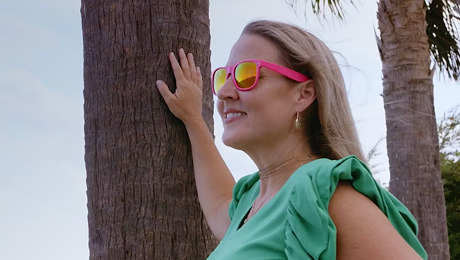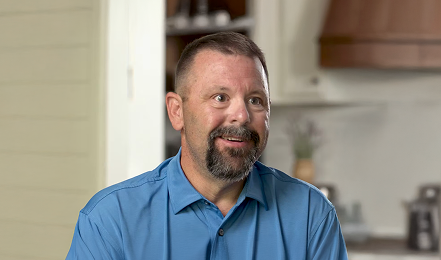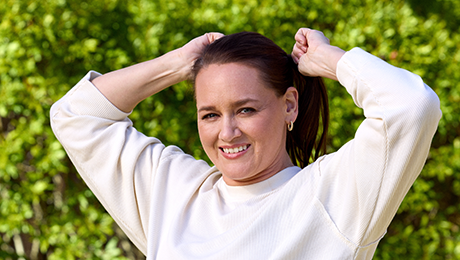People may be able to return to work and life duties within a few days.1 Always follow your doctor's instructions.
Typical ESG recovery timeline and expectations:
First month
While most people return to routine daily activities in two to three days,1 there are a lot of things to adjust to throughout the first month after an ESG. This includes physical recovery, eating differently and going to all follow-up appointments with the care team or nutritionist.

Physical recovery
The ESG procedure takes place under general anesthesia. Depending on the care setting, people remain in observation for four to 24 hours where they’ll often get an IV to ensure proper hydration, and they’ll need a ride home since they can’t drive.2 People also experience varying levels of pain and discomfort from ESG, so it’s important to talk with the care team if ways to control pain are needed.3
The most common physical symptoms post-procedure are nausea, vomiting and abdominal pain, but for most people, these symptoms typically resolve within seven days.2 And there may be side effects from the anesthesia to discuss with the anesthesiologist.3
Post-procedure diet
People need to follow a strict diet for the first two to three weeks which can be both physically and emotionally challenging, since it usually consists of:
Days 1–2: Clear, non-carbonated liquids only and vitamins
Days 3–7: High-protein, low-calorie full liquids low in fat and sugar
Weeks 2–3: Soft and pureed foods3

Months 2–6
At this phase, people are moving out of the post-procedure diet plan, which is why it’s important to keep going to all follow-up appointments with the care team or nutritionist.
Adjusting to both diet and lifestyle changes takes time, but people are also starting to lose weight and see changes. There may be ongoing challenges with feeling supported by friends and family, or stalls in progress, but hopefully people remember what motivated them to take this step in their weight loss journey to begin with.3


“I knew I had to commit to exercise. ESG helped me get here, hot yoga and nutrition helped me stay there.”
- Ellen, an ESG patient
This patient testimonial is sponsored by Boston Scientific. Results are from individual customer testimonials. Results in other cases may vary. In a study, patients with class 1 (BMI 30 to <35 kg/m²) or class 2 (BMI 35 to <40 kg/m²) obesity who underwent ESG in conjunction with prescribed diet and exercise counseling achieved an average of 13.6% total body weight loss at year one.
Months 6–12

People continue to lose weight and are feeling more accustomed to their new diet and lifestyle changes, including being able to establish a regular workout routine.
There may be times people get off-track with their progress, so it’s also helpful to think of more than just numbers, including having more energy for activities or needing new clothes after initial progress made.2
“This procedure and this process and this journey has made me a better me.”
- Scott, an ESG patient

This patient testimonial is sponsored by Boston Scientific. Results are from individual customer testimonials. Results in other cases may vary. In a study, patients with class 1 (BMI 30 to <35 kg/m²) or class 2 (BMI 35 to <40 kg/m²) obesity who underwent ESG in conjunction with prescribed diet and exercise counseling achieved an average of 13.6% total body weight loss at year one.
One year onward
In a study, people experienced 13.6% total body weight loss at one year.1 People also hopefully feel like they are more in control and less likely to be thrown off by previous physical and emotional challenges.2

Frequently asked questions
The post-procedure diet plan is approximately three weeks and progresses from clear liquids to full liquids, then soft to solid foods, but it’s important to stick with the overall diet and lifestyle changes to maintain weight loss progress.3
Carbonated drinks and solid food can cause vomiting, which could cause the sutures or even tissue to tear.3
Getting an ESG is just the start; managing your weight and health will be an ongoing part of your life. Don’t hesitate to get additional support with any physical or emotional challenges you may face, whether it’s seeing a therapist or joining a support group.3
The care team is there to help you achieve your goals, which is why it’s important to attend every follow-up appointment. Talk with the nutritionist about any questions or concerns, since everyone’s experience with the ESG recovery nutrition plan is different.
1. Abu Dayyeh BK, Bazerbachi F, Vargas EJ, et al. Endosopic sleeve gastroplasty for treatment of class 1 and 2 obesity (MERIT): a prospective, multicentre, randomised trial. The Lancet. July 2022;400(10350): 441–451. Accessed July 1, 2025. https://doi.org/10.1016/S0140-6736(22)01280-6
2. Watson S. Endura Patient Experience: Detailed Customer Journey. Boston Scientific Corporation; 2025. 1-18. Accessed July 1, 2025.
3. Endobariatric Dietary Guidebook Post-Procedure Diet. Boston Scientific Corporation; 2024. 1-24. Accessed July 1, 2025.
Important OverStitch Endoscopic Suturing System Safety Information
ESG is performed using a suturing device called OverStitch. Learn about the risks of the OverStitch Endoscopic Suturing System & OverStitch NXT Endoscopic Suturing System (“OverStitch”) for bariatric surgery.
Talk with your doctor to fully understand all the risks and benefits associated with using this device. Ask your doctor whether this device is right for you.
Indications for Use:
OverStitch is for adult patients with obesity with BMI between 30-50 kg/m2. OverStitch can reduce the size of the stomach by stitching the inside. It can also fix the stomach outlet from previous bypass surgery.
When OverStitch is used to help with weight loss, you need to follow a healthy diet and exercise program. You may not lose weight if you do not adopt healthy habits.
Contraindications:
Your doctor will ask you about your medical history and perform a physical exam to decide if OverStitch is right for you. At the time of your procedure, the doctor may detect internal issues that prevent you from receiving OverStitch. For example, stomach ulcers or inflammation in the stomach may impact device placement.
You should not receive OverStitch if you: have a large hiatal hernia; have a history of bleeding in your stomach or food pipe; have a history of eating disorders; are pregnant; have bleeding disorders or are on blood thinners.
Warnings:
Talk to your doctor if you develop major, continued upper abdominal or back pain with difficulty breathing at any time after getting OverStitch.
OverStitch contains nickel. Nickel may cause an allergic reaction in people with nickel sensitivity.
Potential Risks:
Breathing any foreign object or substance such as food, saliva, or stomach contents into your lungs; Intestine blockage; Switching to a different type of surgery; Nausea, vomiting, dehydration; Bleeding; Infection; Swelling, redness, and pain in tissues caused by injury or damage; Damage to or a hole through the tissue around the stomach, food pipe or surrounding organs; Unintended transfer of fluid or gas from one area of the body to another; Pain; Feeling pins and needles; Buildup of fluid around the stomach; Air leaking from the lungs; Difficulty breathing; Narrowing or tightening in the stomach; Wound opening; Death
MRI Safety Information:
OverStitch can be MRI scanned under certain conditions. Scanning under other conditions may result in injury or device malfunction. Inform your doctor or MRI technician of the device before undergoing an MRI scan. This allows them to take any needed precautions.
If you have additional questions, talk with your doctor. For full safety information, visit IFU-BSCI.com.
CAUTION Rx only.

